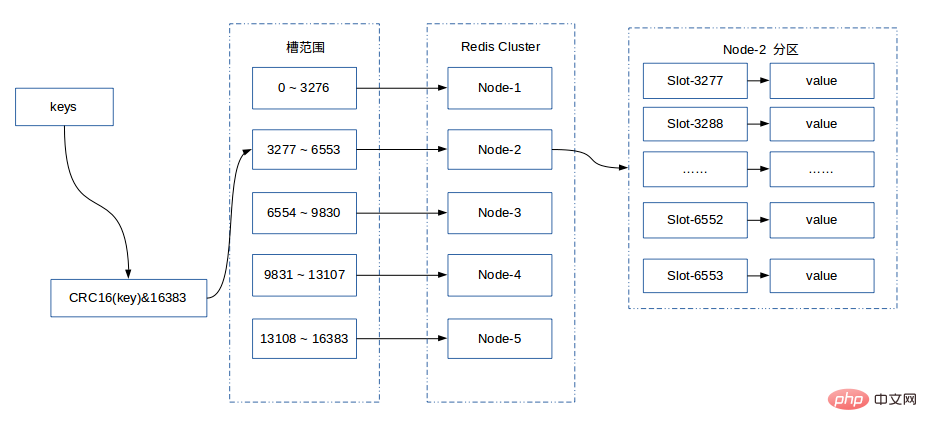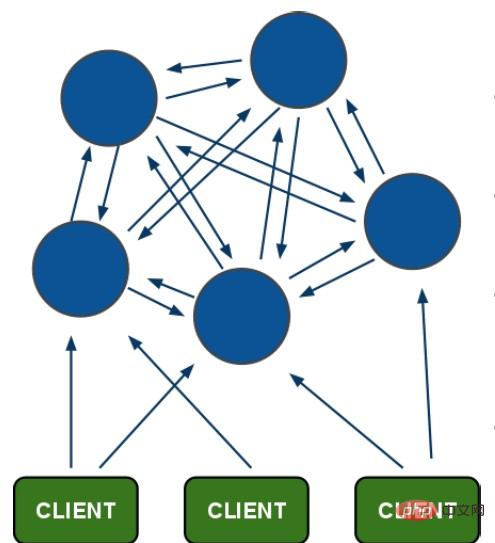Detailed graphic explanation of three Redis deployment solutions

##standaloan (stand-alone mode)
standaloan is redis stand-alone mode, and all services are connected to one redis service, this mode is not suitable for production. If there is a downtime and memory explosion, it may cause cache failure of all services connected to redis and cause an avalanche. (Recommended:redis video tutorial)
ssentinel (Sentinel Mode)
redis-Sentinel (Sentinel Mode) is the high availability officially recommended by Redis (HA) solution, when using Redis as a high-availability solution for Master-slave, if the master goes down, Redis itself (including many of its clients) does not implement automatic master-slave switching, and Redis-sentinel itself does not An independently running process, it can monitor multiple master-slave clusters and switch after it finds that the master is down.
redis-cluster (cluster mode)
redis cluster mode can also achieve high-availability deployment of redis. In Redis Sentinel cluster mode, with the volume of business and data As the performance increases, the performance reaches the single-node bottleneck of redis. Vertical expansion is limited by the machine. Horizontal expansion involves the impact on applications and the risk of data loss during data migration. In response to these pain pointsRedis3.0 launched the cluster distributed cluster solution. When encountering single-node memory, concurrency, and traffic bottlenecks, the cluster solution is used to achieve load balancing. The cluster solution mainly solves the sharding problem, that is, the entire The data is divided into multiple subsets according to rules and stored at multiple different points. Each node is responsible for its own part of the entire data. Redis Cluster adopts virtual slot partitioning in hash partitioning rules. Virtual slot partitioning cleverly uses hash space and uses a hash function with good dispersion to map all data to a set of integers within a fixed range. The integers are defined as slots. The range of Redis Cluster slots is 0 ~ 16383. Slots are the basic unit of data management and migration within a cluster. The main purpose of using a wide range of slots is to facilitate data splitting and cluster expansion. Each node is responsible for a certain number of slots. Redis Cluster uses virtual slot partitioning. All keys are mapped to 0 ~ 16383 according to the hash function. The calculation formula is: slot = CRC16(key)&16383. Each real node is responsible for maintaining a part of the slots and the key value data mapped by the slots. The figure below shows a cluster composed of five nodes. Each node is responsible for an average of approximately 3276 slots, and the process of mapping to the corresponding slots of the corresponding nodes through calculation formulas.redis-cluster architecture diagram

redis introductory tutorial column.
The above is the detailed content of Detailed graphic explanation of three Redis deployment solutions. For more information, please follow other related articles on the PHP Chinese website!

Hot AI Tools

Undresser.AI Undress
AI-powered app for creating realistic nude photos

AI Clothes Remover
Online AI tool for removing clothes from photos.

Undress AI Tool
Undress images for free

Clothoff.io
AI clothes remover

Video Face Swap
Swap faces in any video effortlessly with our completely free AI face swap tool!

Hot Article

Hot Tools

Notepad++7.3.1
Easy-to-use and free code editor

SublimeText3 Chinese version
Chinese version, very easy to use

Zend Studio 13.0.1
Powerful PHP integrated development environment

Dreamweaver CS6
Visual web development tools

SublimeText3 Mac version
God-level code editing software (SublimeText3)

Hot Topics
 1387
1387
 52
52
 How to build the redis cluster mode
Apr 10, 2025 pm 10:15 PM
How to build the redis cluster mode
Apr 10, 2025 pm 10:15 PM
Redis cluster mode deploys Redis instances to multiple servers through sharding, improving scalability and availability. The construction steps are as follows: Create odd Redis instances with different ports; Create 3 sentinel instances, monitor Redis instances and failover; configure sentinel configuration files, add monitoring Redis instance information and failover settings; configure Redis instance configuration files, enable cluster mode and specify the cluster information file path; create nodes.conf file, containing information of each Redis instance; start the cluster, execute the create command to create a cluster and specify the number of replicas; log in to the cluster to execute the CLUSTER INFO command to verify the cluster status; make
 How to clear redis data
Apr 10, 2025 pm 10:06 PM
How to clear redis data
Apr 10, 2025 pm 10:06 PM
How to clear Redis data: Use the FLUSHALL command to clear all key values. Use the FLUSHDB command to clear the key value of the currently selected database. Use SELECT to switch databases, and then use FLUSHDB to clear multiple databases. Use the DEL command to delete a specific key. Use the redis-cli tool to clear the data.
 How to read redis queue
Apr 10, 2025 pm 10:12 PM
How to read redis queue
Apr 10, 2025 pm 10:12 PM
To read a queue from Redis, you need to get the queue name, read the elements using the LPOP command, and process the empty queue. The specific steps are as follows: Get the queue name: name it with the prefix of "queue:" such as "queue:my-queue". Use the LPOP command: Eject the element from the head of the queue and return its value, such as LPOP queue:my-queue. Processing empty queues: If the queue is empty, LPOP returns nil, and you can check whether the queue exists before reading the element.
 How to use the redis command
Apr 10, 2025 pm 08:45 PM
How to use the redis command
Apr 10, 2025 pm 08:45 PM
Using the Redis directive requires the following steps: Open the Redis client. Enter the command (verb key value). Provides the required parameters (varies from instruction to instruction). Press Enter to execute the command. Redis returns a response indicating the result of the operation (usually OK or -ERR).
 How to use redis lock
Apr 10, 2025 pm 08:39 PM
How to use redis lock
Apr 10, 2025 pm 08:39 PM
Using Redis to lock operations requires obtaining the lock through the SETNX command, and then using the EXPIRE command to set the expiration time. The specific steps are: (1) Use the SETNX command to try to set a key-value pair; (2) Use the EXPIRE command to set the expiration time for the lock; (3) Use the DEL command to delete the lock when the lock is no longer needed.
 How to read the source code of redis
Apr 10, 2025 pm 08:27 PM
How to read the source code of redis
Apr 10, 2025 pm 08:27 PM
The best way to understand Redis source code is to go step by step: get familiar with the basics of Redis. Select a specific module or function as the starting point. Start with the entry point of the module or function and view the code line by line. View the code through the function call chain. Be familiar with the underlying data structures used by Redis. Identify the algorithm used by Redis.
 How to solve data loss with redis
Apr 10, 2025 pm 08:24 PM
How to solve data loss with redis
Apr 10, 2025 pm 08:24 PM
Redis data loss causes include memory failures, power outages, human errors, and hardware failures. The solutions are: 1. Store data to disk with RDB or AOF persistence; 2. Copy to multiple servers for high availability; 3. HA with Redis Sentinel or Redis Cluster; 4. Create snapshots to back up data; 5. Implement best practices such as persistence, replication, snapshots, monitoring, and security measures.
 How to use the redis command line
Apr 10, 2025 pm 10:18 PM
How to use the redis command line
Apr 10, 2025 pm 10:18 PM
Use the Redis command line tool (redis-cli) to manage and operate Redis through the following steps: Connect to the server, specify the address and port. Send commands to the server using the command name and parameters. Use the HELP command to view help information for a specific command. Use the QUIT command to exit the command line tool.




